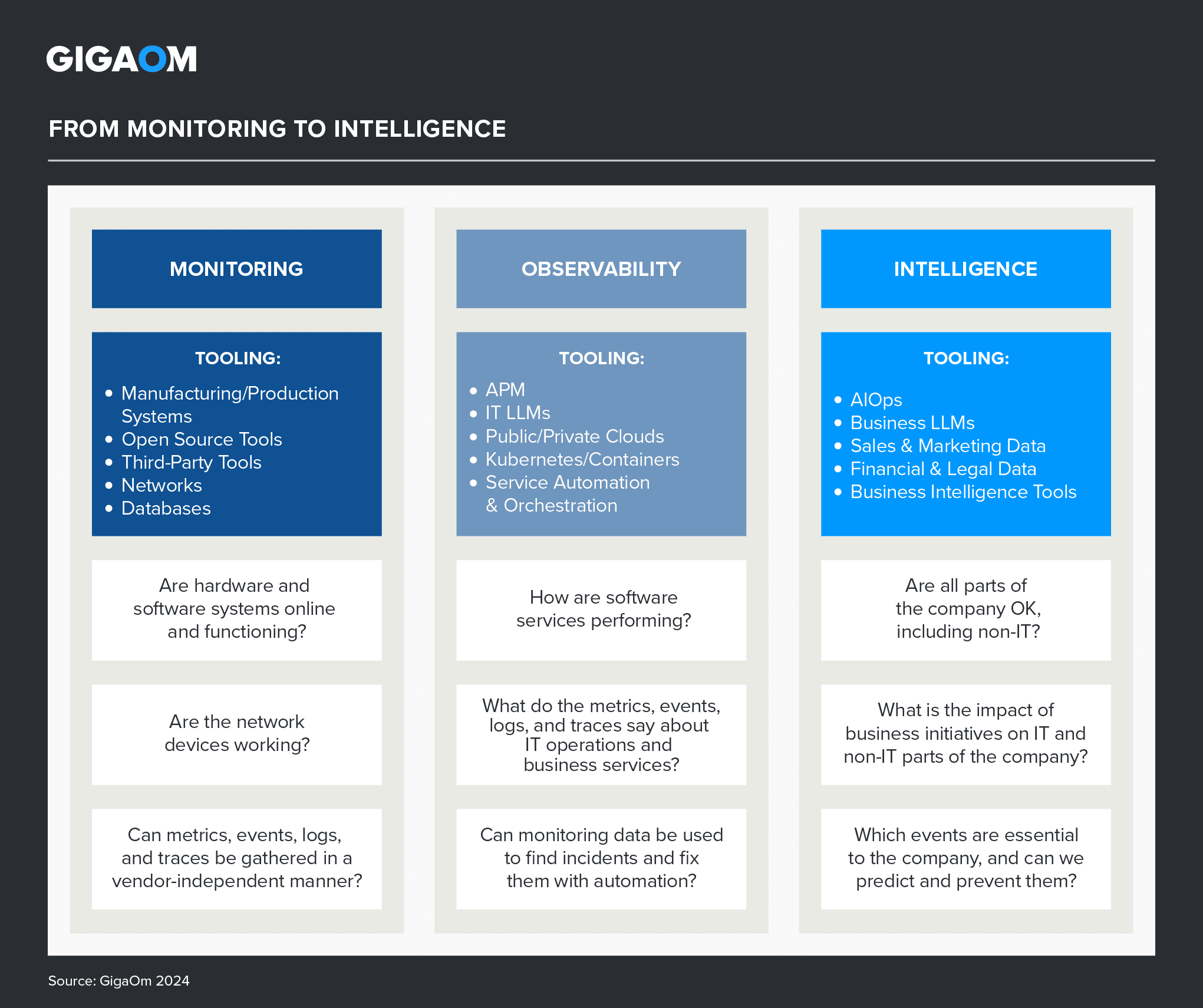Table of Contents
- Executive Summary
- Cloud Observability Sector Brief
- Decision Criteria Analysis
- Analyst’s Outlook
- Methodology
- About Ron Williams
- About GigaOm
- Copyright
1. Executive Summary
Observability aims to monitor and proactively respond to problems in IT infrastructure—or an entire business—by analyzing the massive amounts of data generated by an enterprise. Modern IT organizations instrument and monitor everything, including applications, network access, on-premises and cloud storage, and Kubernetes clusters. The volume of data is far too large for practical human consumption and analysis so companies increasingly rely on observability solutions to capture, analyze, and derive actionable intelligence from all this data.
Specifically looking at cloud observability, monitoring involves data that is created by a wide variety of applications and infrastructure that may reside in—and operate across—multiple public cloud, private cloud, and on-premises networks. Enterprises cannot understand the topology of a critical application or service from monitoring data alone. Cloud computing services, microservices, and remote infrastructure are often distributed between both public and private clouds. Logging is one of the traditional tools for “measuring” the health of a system, but with modern infrastructure scale and complexity, logs often provide only a glut of contextless data. The instrumentation data returned from systems may be in different formats or time signatures, with little context and no chance of timely human correlation and deduplication.
A cloud observability solution gives modern IT organizations more complete, efficient, and actionable visibility across their diverse cloud-based infrastructure. It enables finding answers to critical questions regarding what systems exist, where they are, what they’re doing, who is using them, and how they’re operating from the massive amount of data available for review by IT operations.
Business Imperative
Public and private clouds have become a critical part of businesses regardless of size. The complexity of cloud-based solutions makes them difficult to understand and control, and simple monitoring solutions leave IT teams exposed to a mounting glut of data to sift through.
Cloud observability allows the company to answer critical oversight questions about these systems that monitoring alone cannot reveal. In Figure 1, you can see that monitoring asks questions concerning the status of a device or individual software component. Observability, regardless of tooling, answers more complicated questions.

Figure 1. From Monitoring to Intelligence
Observability uses monitoring data to understand what is happening, what the data means, and information on how to either manually fix incidents or—better still—what can be done to automatically and proactively identify and remediate issues. Observability consumes the data from monitoring and turns it into useful or actionable information for IT operations or other technical specialists with responsibility for software development, infrastructure, networking, or security.
Sector Adoption Score
To help executives and decision-makers assess the potential impact and value of a cloud observability solution deployment to the business, this GigaOm Key Criteria report provides a structured assessment of the sector across five factors: benefit, maturity, urgency, impact, and effort. By scoring each factor based on how strongly it compels or deters adoption of a cloud observability solution, we provide an overall Sector Adoption Score (Figure 2) of 4.6 out of 5, with 5 indicating the strongest possible recommendation to adopt. This indicates that a cloud observability solution is a credible candidate for deployment and worthy of thoughtful consideration.
The factors contributing to the Sector Adoption Score for cloud observability are explained in more detail in the Sector Brief section that follows.
Key Criteria for Evaluating Cloud Observability Solutions
Sector Adoption Score
Figure 2. Sector Adoption Score for Cloud Observability
This is the fourth year that GigaOm has reported on the cloud observability space in the context of our Key Criteria and Radar reports. This report builds on our previous analysis and considers how the market has evolved over the last year.
This GigaOm Key Criteria report highlights the capabilities (table stakes, key features, and emerging features) and nonfunctional requirements (business criteria) for selecting an effective cloud observability solution. The companion GigaOm Radar report identifies vendors and products that excel in those decision criteria. Together, these reports provide an overview of the market, identify leading cloud observability offerings, and help decision-makers evaluate these solutions to make more informed investment decisions.
GIGAOM KEY CRITERIA AND RADAR REPORTS
The GigaOm Key Criteria report provides a detailed decision framework for IT and executive leadership assessing enterprise technologies. Each report defines relevant functional and nonfunctional aspects of solutions in a sector. The Key Criteria report informs the GigaOm Radar report, which provides a forward-looking assessment of vendor solutions in the sector.